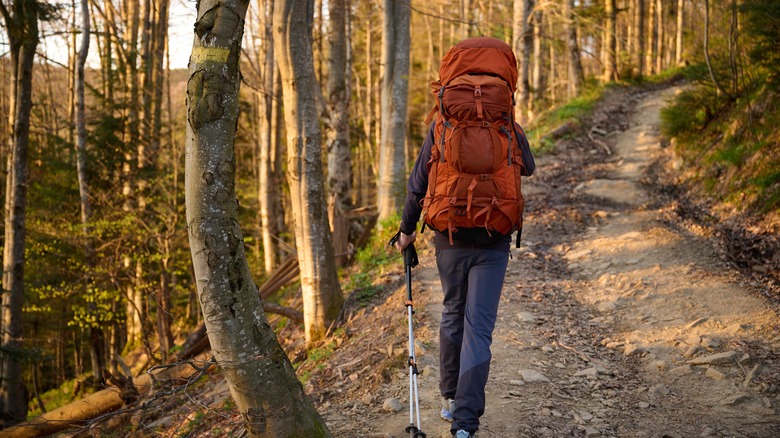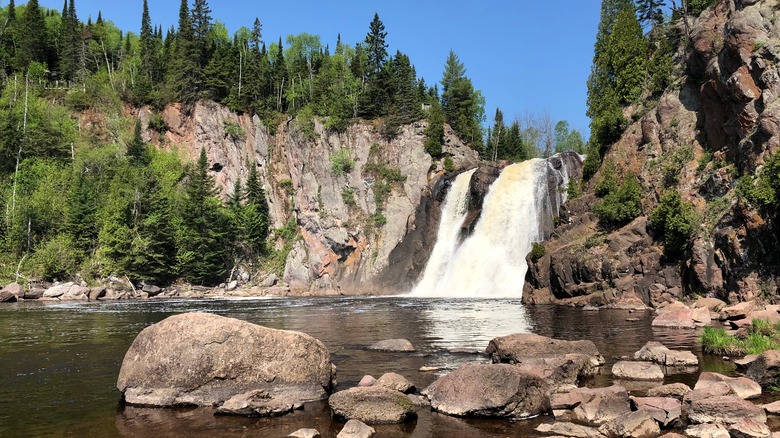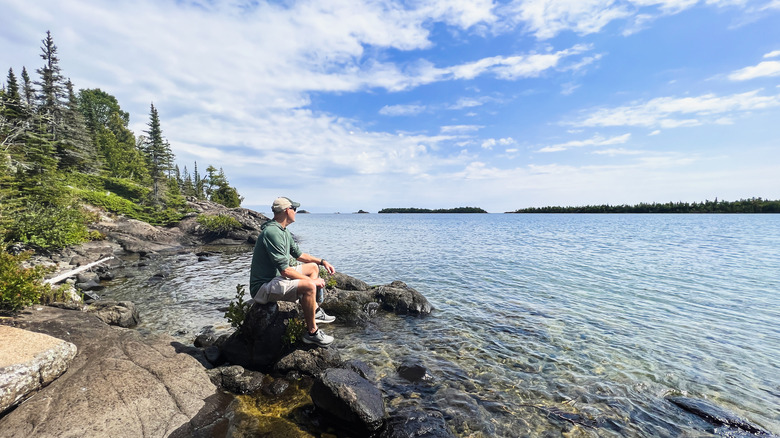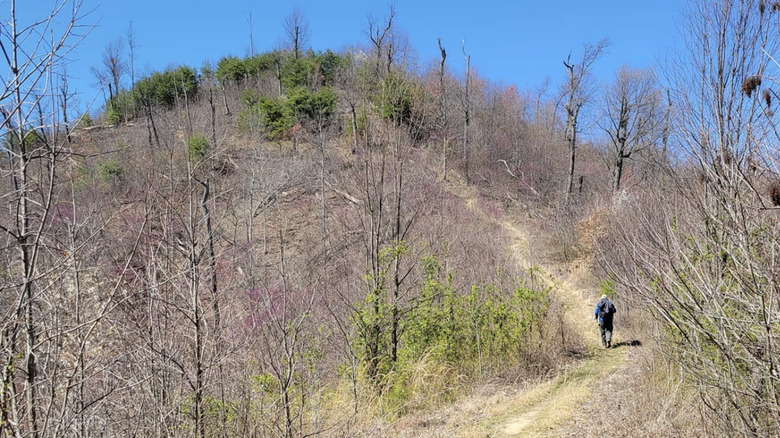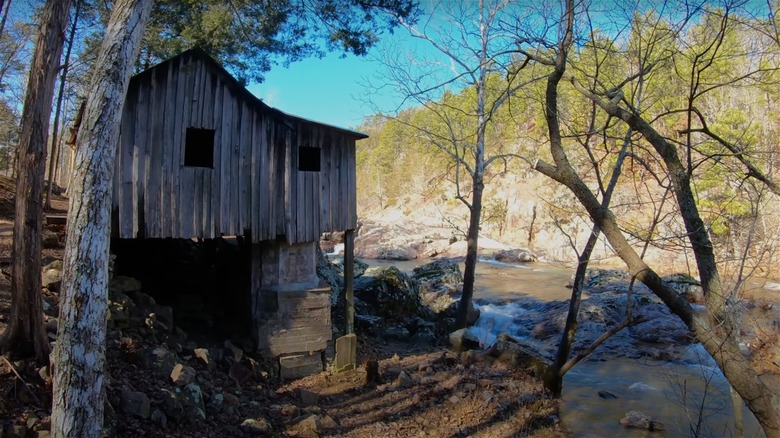The Best Backpacking And Thru-Hiking Trails In The Midwest
If you are looking for a way to get outside and reconnect with yourself and nature, then there is nothing better than hitting the trails for a multi-day hiking adventure. Whether you prefer backpacking, thru-hiking, or a little bit of both, when thinking of long-distance trails, most people typically imagine large multi-country hiking trails or some of the most famous trails in the U.S., like the Pacific Crest Trail or the Appalachian Trail. However, the problem with these well-known and famous trails is that they can be crowded and some even require difficult-to-get hiking permits or backcountry camping permits.
Luckily, there are still plenty of under-the-radar backpacking and thru-hiking trails in America that will provide that same one-with-nature experience without the crowds or permits, and many of them are located in an unexpected place — the Midwest. The Midwest is often overlooked when it comes to hiking because it doesn't have particularly high mountains or beautiful deserts. But what the Midwest does have are rolling hills, national forests, multiple Great Lakes, and gorgeous sandstone canyons. If you don't want to spend multiple days thru-hiking, all of these Midwestern trails are also great for day hikers and section hikers who want to break up the trail into smaller pieces and complete it over multiple months or years. So, if you are looking for some long-distance trails in America's Heartland, here are some incredible hikes that you won't forget.
The Superior Hiking Trail, Minnesota
Starting from the border between Northern Minnesota and Canada, the Superior Hiking Trail follows a route down through Minnesota along the coast of Lake Superior, stopping at ridge tops with excellent views of the largest of America's Great Lakes along the way. You will also be treated to views of numerous waterfalls,beaches, and gorgeous forests. In fact, according to one Redditor, the Superior Hiking Trail is "basically endless forest to the north all the way to the arctic and views of Lake Superior to the south."
This trail follows the lake southwards and then passes through Duluth before finally ending after Route 35 — covering over 300 miles. You can also hike the trail in the other direction (south to north), which many trekkers prefer because it involves starting out on flatter land and then working your way up to the hillier sections. Completing the entire Superior Hiking Trail often takes hikers anywhere from two to four weeks depending on walking speed and number of stops. You can also choose to make your thru-hike shorter by hiking specific sections. The Superior Hiking Trail Section 6 is a popular section that starts in Grand Marais, passes through a few state parks and by the High Falls, and then ends at a scenic overlook. This section typically takes around 20 hours to complete and can be broken up over two or more days.
One of the best things about this trail is that it contains plenty of campsites (around 94 dispersed across the hike) all of which don't require reservations or permits. All of the campsites even come equipped with backcountry toilets which, if you've ever thru-hiked before, you know is a luxury.
Isle Royale National Park, Michigan
Isle Royale National Park is an often-overlooked island park that is located in Michigan above the Upper Peninsula near the border with Canada. Because of its remote location in the middle of Lake Superior, the only way to reach Isle Royale is via ferry, private boat, or seaplane. All three transport options can be booked from ports in both northern Michigan and Minnesota. Cars and motor vehicles are not allowed on the island — so, while there, you will be completely surrounded by nature and wildlife.
While there are multiple thru-hiking and backpacking trails in Isle Royale National Park, one of the most well-known paths is the Greenstone Ridge Trail which is a 40-plus-mile hike that traverses the spine of the island offering incredible views of Lake Superior and the surrounding area. Depending on your walking speed, completing this trail can take anywhere from five to eight days. There are also plenty of campsites along the way that come with water sources and outhouses. Although you do need a camping permit to pitch a tent on the island, the permits are free if your group is six people or less and can be applied for upon arrival. The entrance fee for Isle Royale National Park is $7.
One of the best things about this thru-hike is how secluded and alone with nature you feel on the trail. In fact, according to reviewers on AllTrails, it's not uncommon to glimpse large wildlife along the way, with one hiker noting that they "saw gorgeous bull moose on the trail."
Knobstone Trail, Indiana
As the longest natural footpath in Indiana, the Knobstone Trail spans a distance of around 60 miles through an area of southern Indiana known for its hilly topography. This trail is a well-marked and maintained path that is perfect for anyone starting out their journey of backpacking or thru-hiking. Completing the Knobstone Trail typically takes anywhere from two to three days, with one poster on the WhiteBlaze forum making two days their goal for the trail and another trekker on Reddit noting that they completed the hike in three days as a new backpacker.
While this trail is often recommended by backpackers as a good training route for the AT, that doesn't mean you should take it for granted. In fact, the Knobstone Trail is hilly and full of ups and downs that have earned it the label of difficult. One reviewer on AllTrails described the Knobstone Trail as being full of "very difficult terrain with hills and valleys that are relentless and plentiful," warning that hikers should "train prior to tackling the full trail."
If you decide to give Knobstone Trail a shot, you will enjoy your journey through the beautiful state forests of southern Indiana and possibly even catch a glimpse of the Ohio River. There are no established campsites along the trail, but primitive camping is allowed. It is also important to carry and cache plenty of water because streams along the creek often dry out in summer and are not a reliable source of water.
The Ozark Trail, Missouri
The Ozark Trail in Missouri is another great Midwestern thru-hike and takes trekkers through plenty of interesting and varied terrain from beautiful forests and rocky streams to hidden caves and scenic glades. This trail spans around 230 miles from the Onondaga Trailhead located in Onondaga State Park (a one to two hour drive from St. Louis) southwards to the Eleven Point Western Trailhead (near the border with Arkansas). As such, this hike will bring trekkers through eight different sections of the Ozark Trail system over the course of around 10 days (although one ultra light thru-hiker on Reddit managed to complete the trail in only eight days).
Although the Ozark Trail can be hiked year round, most thru-hikers avoid summer because of the high temperatures and uncomfortable weather. As one thru-hiker who completed the Ozark Trail in spring of 2019 told Terrain, you should also prepare for the undeveloped nature of the trail. "[The Ozark Trail] is more raw than other trails I've thru-hiked. There are few bridges over creek crossings and hardly any developed campsites."
It's this quiet nature of the Ozark Trail that's one of its biggest draws — especially for thru-hikers and backpackers looking to get away from the crowds, permits, and paid campsites of the Appalachian Trail and the Pacific Crest Trail.
The River to River Trail, Illinois
As a 160-mile long trail passing through the most beautiful areas of the Shawnee National Forest in Southern Illinois, the River to River Trail is a must-do for people who love sandstone cliff scenery and rolling hills. Starting in Elizabethtown on the Ohio River and crossing westward across the state all the way to the Mighty Mississippi, backpacking this trail often takes anywhere between two and three weeks. There are no permits or fees required to thru-hike this trail. Although the trail does have four established campsites, most of the trail requires setting up a primitive campground which is perfect for people who really want that "alone in the wild" vibe.
As opposed to the other thru-hikes on this list, this trail is often split into sections. One Redditor on r/WildernessBackpacking "did the first 100 miles of the [River-to-River] trail in March of 2020" and then returned later for the final 60 miles, done in four days. Although many hikers love this trail for the views, one major complaint is that it is also used by horses who tend to take up a large portion of the path. Another common complaint on AllTrails was difficulty finding water sources in autumn when the creeks dry up. Because of this, it may be best to tackle this trail in the spring or after a period of heavy rain.
